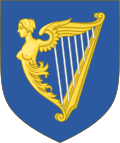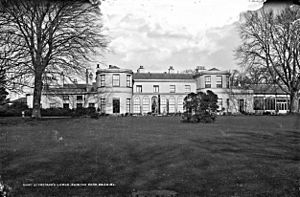Chief Secretary for Ireland facts for kids
Quick facts for kids Chief Secretary for Ireland |
|
|---|---|

Arms of the Kingdom of Ireland
|
|
| Style | The Right Honourable as a member of the Privy Council |
| Residence | Chief Secretary's Lodge (from 1776) |
| Appointer | The Lord Lieutenant |
| Term length | At the pleasure of the Lord Lieutenant |
| Inaugural holder | Edward Waterhouse |
| Formation | 20 January 1566 |
| Final holder | Sir Hamar Greenwood |
| Abolished | 19 October 1922 |

The Chief Secretary's residence was the Chief Secretary's Lodge in the Phoenix Park, next to the Viceregal Lodge.
The Chief Secretary for Ireland was a very important political job in the British government that ruled Ireland. This role was part of the British administration in Ireland. Even though the Chief Secretary was officially under the Lord Lieutenant, they were actually the main government official for Ireland.
From the early 1800s until British rule ended, the Chief Secretary acted like a government minister. Their job was similar to a Secretary of State in the UK, like the one for Scotland. Often, the Chief Secretary was the one who joined the British Cabinet, not the Lord Lieutenant. The Chief Secretary also led the Local Government Board for Ireland after it was created in 1872.
British rule in most of Ireland ended because of the Irish War of Independence. This war led to the creation of the Irish Free State. Because of these changes, the job of Chief Secretary was ended. The role of Lord Lieutenant also ended. New leaders took over in the Irish Free State and Northern Ireland. These were the President of the Executive Council (like a prime minister) and the Prime Minister of Northern Ireland. Matters for Northern Ireland then became the responsibility of other UK government roles.
Contents
Understanding the Chief Secretary's Role
For a long time, the Lord Lieutenant was the most powerful person in the British government in Ireland. This was especially true at Dublin Castle. Laws like Poynings' Law meant that the Irish Parliament could not start new laws on its own. The Crown kept control of the government through officials sent from London. These officials did not have to answer to the Irish Parliament.
In 1560, Queen Elizabeth I wanted to make the Irish government better. She also wanted to keep the Lord Lieutenant in check. So, she ordered the Lord Lieutenant to appoint John Challoner as Secretary of State for Ireland. The jobs of Secretary of State for Ireland and Chief Secretary of Ireland were separate at first. But in 1796, Thomas Pelham was the first person to hold both jobs at the same time.
Over time, the Chief Secretary's job became more and more important. They were in charge of getting new laws passed in the Irish House of Commons. The Chief Secretary was also a MP in Ireland. This made them act almost like a prime minister. Even though the Irish government did not have to answer to the Irish Parliament, it still needed to work with it to pass laws.
A Chief Secretary named Viscount Castlereagh played a big part in passing the Act of Union. This law was passed in the Irish Parliament in 1800. It happened through special favors and even direct payments. After the Act of Union on January 1, 1801, the Kingdom of Ireland joined the United Kingdom of Great Britain and Ireland. The Irish Parliament stopped existing. However, the way Ireland was governed mostly stayed the same. The Lord Lieutenant and Chief Secretary kept their roles.
The last Chief Secretary who was also an MP for an Irish area was Chichester Parkinson-Fortescue. He was the MP for County Louth from 1868 to 1871.
The very last Chief Secretary was Sir Hamar Greenwood. He left his job in October 1922. The Irish Free State became independent on December 6, 1922. This new state covered most of Ireland. In Northern Ireland, a new government was set up with its own Prime Minister of Northern Ireland. This government was later stopped in 1972. A new job, the Secretary of State for Northern Ireland, was then created in the British cabinet.
Key Chief Secretaries for Ireland
This section lists some of the important people who held the job of Chief Secretary. This was a very important political role in the British government in Ireland. The Chief Secretary was usually the main government official for Ireland. They often sat in the British Cabinet.
Chief Secretaries in the Kingdom of Ireland (1566–1801)
The Chief Secretary's role grew in power during this time. They helped manage the Irish Parliament and later played a big part in the Act of Union.
| Name | Portrait | Term of office | Served under | |
|---|---|---|---|---|
| Edward Waterhouse |  |
20 January 1566 | 9 October 1567 | Sir Henry Sidney |
| Edmund Spenser |  |
7 September 1580 | 30 August 1582 | The Lord Grey de Wilton |
| Henry Wotton |  |
15 April 1599 | 4 September 1599 | The Earl of Essex |
| Sir Cyril Wyche |  |
1677 | 1682 | The Duke of Ormonde |
| Joseph Addison |  |
1708 | 1710 | The Earl of Wharton |
| Horatio Walpole |  |
1720 | 1721 | The Duke of Grafton |
| William Eden |  |
1780 | 1782 | The Earl of Carlisle |
| Viscount Castlereagh |  |
1798 | 1801 | The Marquess Cornwallis |
Chief Secretaries in the United Kingdom (1801–1922)
After the Act of Union, the Chief Secretary continued to be the main person in charge of Ireland's day-to-day government.
| Name | Portrait | Term of office | Political party | ||
|---|---|---|---|---|---|
| Sir Arthur Wellesley Later became a famous general and Prime Minister. |
 |
1807 | 1809 | Tory | |
| Robert Peel Later became Prime Minister of the UK. |
 |
1812 | 1818 | Tory | |
| Edward Cardwell |  |
24 June 1859 | 29 July 1861 | Liberal | |
| Henry Campbell-Bannerman Later became Prime Minister of the UK. |
 |
23 October 1884 | 9 June 1885 | Liberal | |
| Arthur Balfour Later became Prime Minister of the UK. |
 |
7 March 1887 | 9 November 1891 | Conservative | |
| Sir Hamar Greenwood, Bt The last Chief Secretary for Ireland. |
 |
2 April 1920 | 19 October 1922 | Liberal | |
See also
 In Spanish: Jefe de Secretaría de Irlanda para niños
In Spanish: Jefe de Secretaría de Irlanda para niños
- Secretary of State for Northern Ireland, a similar job in the British cabinet that started in 1972.


